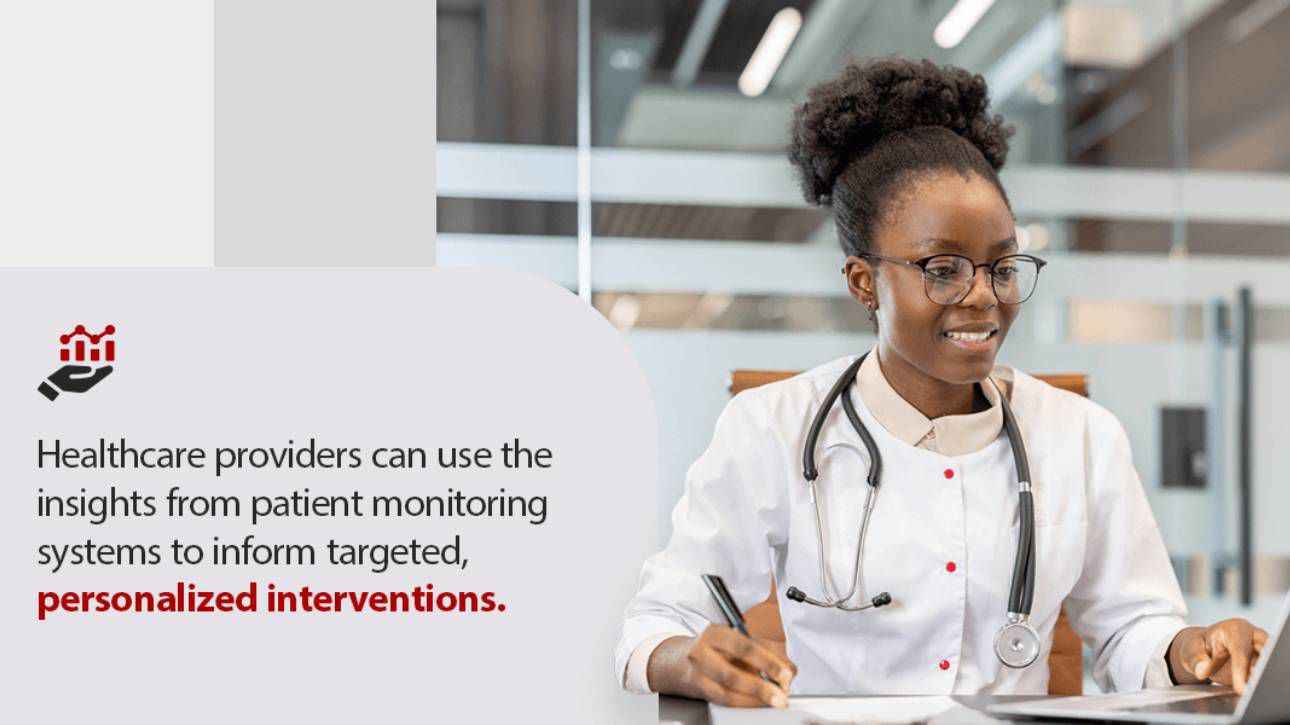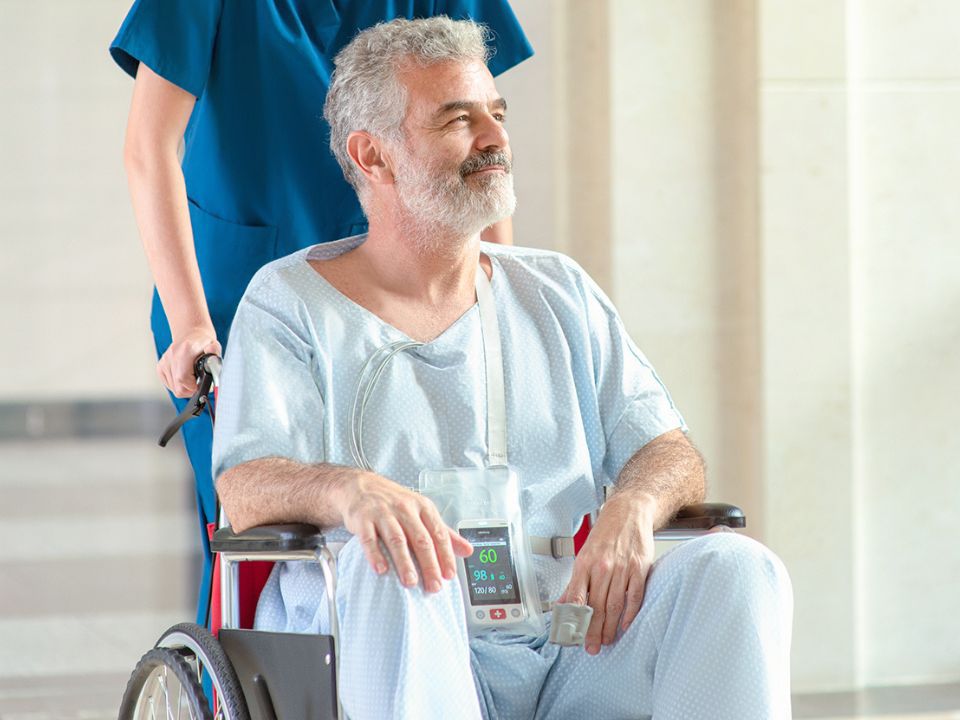Hospital readmissions are unfavorable for both healthcare providers and patients. Advancing technologies allow for more detailed and insightful inpatient health monitoring to continuously track important metrics and identify issues before they become more serious health risks that would lead to readmission in the future.
Explore how to prevent readmissions in hospitals with the help of advanced patient monitoring solutions.
How Patient Monitoring Can Prevent Hospital Readmissions
Patient monitoring devices such as telemetry monitoring can be advantageous in preventing hospital readmissions. These systems support early detection of potential complications and enable proactive intervention by healthcare providers. Here's how monitoring solutions are enhancing patient care outcomes by lowering the probability of readmission post-discharge:
Real-Time Data Analysis
Advanced monitoring devices can continuously collect a patient's physiological data, such as:
- Heart rate
- Respiration rate
- Pulse oximetry (SpO2)
- Blood pressure
- Temperature
Central monitoring systems can analyze this information, comparing the data against established baseline values. When the monitoring device detects deviations in the patient's condition, it alerts healthcare providers to support faster intervention.
For example, clinicians can closely track the vitals of ambulating patients with monitors that have telemetry capabilities and connect to a distributed monitoring system (DMS). They can detect subtle changes in a patient's heart rate and SpO2 from a centralized platform in real time as the patient ambulates.
The telemetry monitoring system can be programmed to trigger an alarm at the DMS so healthcare professionals can promptly intervene and prevent a life-threatening cardiac event or other acute condition. This is particularly critical for patients who require continuous cardiac monitoring.
Proactive Pattern Recognition
Patient monitoring solutions can leverage machine learning (ML), artificial intelligence (AI), and advanced algorithms to identify patterns in patient data that can indicate a potential concern. These systems analyze complex relationships between data points and flag patients who are at risk of deterioration, even before more significant symptoms are evident.
Healthcare providers can use the insights from patient monitoring systems to inform targeted, personalized interventions. For instance, patient monitors with customization options allow clinicians to establish baseline parameters based on typical patterns per individual. They can customize the alarm limits according to individual needs to catch issues early, while at the same time reducing alarm fatigue for clinicians.
Enhanced Communication
Another way patient monitoring can help prevent hospital readmissions is by facilitating better communication between healthcare providers across departments, enabling efficient care coordination.
By collecting and transmitting real-time data to a DMS, patient monitoring systems provide clinicians across departments with immediate access to a patient's vital signs. Healthcare professionals can promptly respond to alerts and coordinate care in a streamlined manner, with fewer opportunities for miscommunication.
Enhanced communication can also help prevent patients from getting discharged too early, which could increase the risk of readmission.
For example, a nurse can closely monitor an ambulating patient's heart rate in the telemetry unit from the DMS and detect subtle changes. They can compare this data to the patient's baseline, identify a potential issue, and notify the patient's care team of their concern.
The healthcare team can then access this information in the DMS, regardless of where they're located within the facility, and collaboratively determine whether the patient is ready to be discharged or requires further care.
Key Benefits of Preventing Hospital Readmissions With Patient Monitoring
Fewer hospital readmissions result in many positive impacts for both patients and providers, including:
Enhancing Patient Satisfaction
With continual, seamless access to patient data, healthcare professionals are empowered to be more responsive. Patients and their caregivers can feel more confident in their care when they know they are being vigilantly monitored, enabling clinicians to build more impactful relationships with their patients.
Configurable patient monitoring solutions also enable clinicians to deliver more personalized care, which not only enhances treatment and decreases the risk of readmission but also helps patients experience more specialized care according to their clinical circumstances.
Improving Patient Outcomes
Patient monitoring gives healthcare providers greater insight into patient health, even when symptoms are not immediately obvious. These solutions can contribute to quicker detection of complications and potential issues. This translates to more timely treatment plan adjustments to support improved health outcomes and enable more confident decision-making about a patient's discharge, with the end goal to reduce readmission risk.
Reducing Workloads for Care Providers
Readmissions often require emergency care and more hands-on time from clinicians. One prevalent example is sepsis — sepsis has a high readmission rate and requires immediate care. Healthcare providers can help prevent sepsis-related readmissions by detecting signs early through closely monitoring relevant parameters, like respiratory rate and temperature.
Boosting Cost Savings
Hospital readmissions can be expensive and typically result in out-of-pocket costs for patients. Lower readmission rates also benefit hospitals financially due to improved resource utilization, decreased administrative burden, and compliance. Through the Hospital Readmissions Reduction Program, the Centers for Medicare and Medicaid Services can penalize hospitals with high readmission rates, reducing reimbursements by as much as 3%.
Hospitals can invest the money saved by decreasing readmissions into upgrading their equipment to improve patient care across the facility.
Types of Patient Monitoring Solutions
Providers use various types of patient monitoring solutions for hospital patients of all acuity levels, including:
- Telemetry: Telemetry monitors track heartbeats and other vital signs for ambulatory patients, giving them the freedom to move around the facility while still offering peace of mind for healthcare providers and the patient. Some telemetry transmitter technologies are also beneficial for patient monitoring during transport
- Bedside: Bedside patient monitors track a broad range of parameters, including more complex parameters like cardiac output and stroke volume variation. They are purpose-built to enable in-depth assessments of patient conditions and are essential in high acuity and mid or low acuity settings
- Transport: Transport monitors allow clinicians to continuously monitor a patient's vitals as they're transferred to different units or floors. These monitors are typically compact, lightweight, and durable. They have ample battery runtime to allow for uninterrupted monitoring and transmit data wirelessly to the DMS
At Mindray, our mission is to advance medical technologies to make healthcare more accessible. We offer various telemetry patient monitoring devices, including the BeneVision TM80 and BeneVision TM70 Telemetry Transmitters, as well as continuous, transport, and vital signs monitoring solutions.
Our patient monitoring technology enables more efficient and adaptable workflows, featuring user-friendly interfaces and configurability capabilities. Mindray's solutions also come with dedicated service and support to ensure healthcare professionals can get the most out of the equipment.
Ready to start a partnership in delivering better patient care? Contact us today to learn more about our advanced patient monitoring products.









